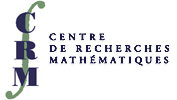 |
|
||||
Org: Salvador Pérez-Esteva (UNAM) and Malabika Pramanik (UBC)
[PDF]
- MÓNICA CLAPP, Universidad Nacional Autónoma de México, Instituto de Matemáticas, Circuito Exterior C.U., 04510 México D.F., Mexico
Periodic and Bloch solutions to a magnetic nonlinear Schrödinger equation [PDF] -
We consider the equation
where A Î C1,a (RN,RN) is the magnetic potential associated to a magnetic field B = curl(A) and V Î C0,a (RN) is an electric potential. We assume that A and V are 2p-periodic in each variable, V > 0, and p Î (2,2*) with 2* : = ¥ if N=2, 2* : = [(2N)/(N-2)] if N ³ 3. We shall address two questions: the gauge-dependence problem for 2p-periodic solutions u : RN ® C, and the multiplicity of Bloch solutions. Unlike the nonperiodic case where problem (ÃA) is basically independent of A (it is gauge invariant), in the periodic case this is far from being true. Under some assumptions on A we show that, if there exists a one-to-one correspondence between the 2p-periodic solutions of (ÃA) and those of (ÃA+z) preserving their absolute value, then z lies in a subset of measure zero of RN. We use this fact to show the existence of an uncountable set of Bloch solutions with real quasimomentum having small energy.(ÃA) (-iÑ+A)2 u + Vu = |u|p-2 u, This is joint work with Renato Iturriaga and Andrzej Szulkin.
- BRIAN COOK, University of British Columbia
A Restricted Roth Theorem Over Finite Fields [PDF] -
Given a set A Ì Fpn with at least dpn elements, d > 0, we will discuss finding triples {(x,x+d,x+2d) Î A×A×A : d Î V}, where V = {x Î Fpn : f1(x) = ¼ = fR(x) = 0} is the zero set of homogeneous polynomials f1,...,fR all of fixed degree d.
This is joint work with Akos Magyar.
- GALIA DAFNI, Concordia University, 1455 de Maisonneuve Blvd. West, Montreal, Quebec H3G 1M8
An atomic decomposition of the Hajlasz Sobolev space M11 on manifolds [PDF] -
We compare several possible notions of Hardy-Sobolev spaces on a manifold with a doubling measure. In particular, we consider several characterizations of these spaces, in terms of maximal functions, atomic decompositions, and gradients, and apply them to the L1 Sobolev space M11, defined by Hajlasz.
Joint work with N. Badr.
- MAGALI FOLCH, Instituto de Matemáticas, UNAM
An affine invariant inequality and applications in harmonic analysis [PDF] -
We extend an affine invariant inequality previously established for vector polynomials to general rational functions. We then prove several estimates for problems in harmonic analysis defined with respect to the affine arc-length measure.
This is joint work with Spyridon Dendrinos (University of Bristol) and James Wright (University of Edinburgh).
- KATHRYN HARE, University of Waterloo
Sets of zero discrete harmonic density [PDF] -
The set E Í Z is said to have zero discrete harmonic density (zdhd) if for every open U Í T and discrete measure m, there is a discrete measure, n, supported on U with [^(m)] = [^(n)] on E. I0 sets are examples of sets which have zdhd. We study properties of these sets. Our motivation is to provide a new approach to two long-standing problems involving Sidon sets.
This is joint work with Colin Graham.
- MARCOS LÓPEZ, UNAM, Área de la investigación Científica, Cd. Universitaria Coyoacán 04510, México D.F.
Functional equations related to indeterminate moment problems [PDF] -
For b Î R, p > 0, and 0 < q < 1 fixed, we characterize the integrable functions on (0,¥) satisfying the functional equation f(qx) = qb-1/2 (x+pq-1/2) f(x), and show that they are solutions to the generalized Stieltjes-Wigert moment problem.
- AKOS MAGYAR, University of British Columbia
Singular Radon transforms on discrete nilpotent groups [PDF] -
Singular and maximal Radon transforms are generalizations of singular integrals and maximal functions, when averages are taken over curves and surfaces. If they are given in terms of integral polynomials, such transformations have natural discrete analogues whose lp mapping properties are related to questions both in ergodic and number theory.
We plan to survey some past results in the discrete settings, as well as to discuss the l2 bounds of singular averages over polynomial "curves" on the integral (3 by 3) upper triangular group.
This is joint work with A. Ionescu, E. M. Stein and S. Wainger.
- EMILIO MARMOLEJO, Instituto de Matematicas, Unidad Cuernavaca, UNAM, Mexico
Hardy Spaces, Singular Integrals and the Geometry of Euclidean Domains [PDF] -
We study the interplay between the geometry of Hardy spaces and functional analytic properties of singular integral operators (SIO's), such as the Riesz transforms as well as Cauchy-Clifford and harmonic double layer operator, on the one hand and, on the other hand, the regularity and geometric properties of domains of locally finite perimeter. Among other things, we give several characterizations of Euclidean balls, their complements, and half-spaces, in terms of the aforementioned SIO's.
Joint work with Steve Hofmann, Salvador Perez-Esteva, Marius Mitrea and Michael Taylor.
- LINO RESÉNDIZ, Universidad Autonoma Metropolitana-Azcapotzalco, Av. San Pablo 180, Mexico D.F.
Qp n-dimensional classes [PDF] -
Let n ³ 3 and B be the unit ball in Rn. Denote by GM(B) = {fa*} the group of all Möbius transformations of the unit ball onto itself and SH the class of subharmonic functions u : B®R. Consider
the modified solution of the Laplacian in Rn compose with a Möbius transformation fa* of the unit ball onto itself. Let 0 £ p < ¥. We say that the function u belongs to the subharmonic class Qp,gsh if u Î SH andg(x,a*) = |fa*(x) |2-n-1 = 1 |fa*(x) |n-2-1,
In this talk we present several properties of this class and associated subclasses, like Dirichlet and Bloch classes. Classical Qp-analytic spaces in C were introduced by Aulaskari and Lappan. In higher dimensions, Qp-monogenic spaces were studied using Quaternionic and Clifford analysis. Since the subharmonic class is a very wide class, the results presented here are quite more general.
sup
|a* | < 1ó
õ
Bu2(x) æ
è1 |fa*(x) |n-2- 1 ö
øp
dBx < ¥. - HONG YUE, Trine University, 1 University Ave., Angola, IN, 46703, USA
A Lp-version of the John-Nirenberg Lemma in Metric Spaces [PDF] -
John and Nirenberg (1961) introduced the space BMO(Q) and a larger space which we call the John-Nirenberg space with exponent p and denote by JNp(Q), where Q is a finite cube in Rn. They proved two lemmas for functions in BMO(Q) and JNp(Q) respectively. The first one characterizes functions in BMO(Q) in terms of the exponential decay of the distribution function of their oscillations. The second shows that any function in JNp(Q) is in weak Lp(Q).
We first give a new proof for John-Nirenberg lemma II on Rn by using a dyadic maximal operator and a good lambda inequality. Then, we discuss the space JNp and the corresponding lemma in the context of a doubling metric measure space.
Joint work with D. Aalto, L. Berkovits, O. E. Maasalo.
- PING ZHOU, St. Francis Xavier University
On L1-convergence of Fourier series under MVBV condition [PDF] -
Let f Î L2p be a real-valued even function with its Fourier series
and let Sn (f,x), n ³ 1, be the n-th partial sum of the Fourier series. It is well known that if the nonnegative sequence {an} is decreasing and limn® ¥ an = 0, then1 2a0 + ¥
å
n=1an cosnx,
if and only if
lim
n® ¥||f-Sn (f) ||L = 0
We weaken the monotone condition in this classical result to the so-called mean value bounded variation (MVBV) condition. Our main result gives the L1-convergence of a function f Î L2p in complex space, and the generalization of the above classical result is a special case in the real-valued function space.
lim
n® ¥an logn = 0. This is joint work with D. S. Yu and S. P. Zhou.
- LEANDRO ZUBERMAN, University of Waterloo, Pure Math Department, Waterloo, Ontario, Canada, N2L 3G1
A Fractal Plancherel Theorem [PDF] -
A measure m on Rn is called locally and uniformly h-dimensional if m( Br(x) ) £ h(r) for all x Î Rn and for all 0 < r < 1, where h is a real valued function. If f Î L2(m) and Fmf denotes its Fourier transform with respect to m, it is not true that Fmf Î L2.
We prove that, under certain hypothesis on h, for any f Î L2(m) the L2-norm of its Fourier transform restricted to a ball of radius r has the same order of growth as rn h(r-1), when r®¥. Moreover, we prove that the ratio between these quantities is bounded by the L2(m)-norm of f:
By imposing certain restrictions on the measure m, we can also obtain a lower bound for this ratio:
sup
x Î Rn
sup
r ³ 11 rn h(r-1)ó
õ
Br(x)|Fmf(x)|2 dx £ C ||f||22.
These results generalize the ones obtained by Strichartz in [1] where he considered the particular case in which h(x) = xa.
liminf
r®¥1 rn h(r-1)ó
õ
Br(y)|Fmf(x)|2 dx ³ c ó
õ
E|f|2 dhauh. References
- [1]
- R. Strichartz, Fourier asymptotics of fractal measures. J. Funct. Anal. 89(1990), 154-187.






